 |
|
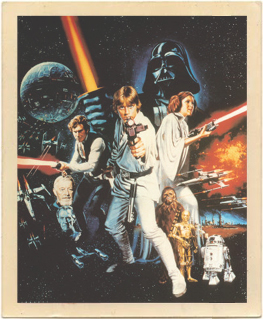 Star Wars Star Wars1977. 20th Century Fox, Fox Home Video, Color, Aspect Ratio 2.20 : 1, 121 minutes, Rated PG Release Date: May 25, 1977 Star Wars is available at Amazon.com as a 2-Disc Widescreen Edition DVD, as part of the Star Wars Original Triology DVD Set, in the Star Wars Complete Saga Blu-Ray Set, and on VHS. Movie Synopsis: In a galaxy far, far away, young Luke Skywalker leaves his home planet and teams up with newly met allies (Han Solo, Chewbacca, Ben Kenobi, C-3PO, and R2-D2) in an attempt to rescue rebel leader, Princess Leia, from the clutches of the evil Darth Vader. Cast: Mark Hamill, Harrison Ford, Carrie Fisher, Peter Cushing, Alec Guinness, Anthony Daniels, Kenny Baker, James Earl Jones Director: George Lucas Thoughts on the Movie: This is it. The real deal. The daddy-of-them-all of modern-day Sci-Fi movies. Star Wars. And it is way more than a movie; it was, and still is, a cultural phenomenon. I loved it when I first saw it on the big screen back in 1977. Me, my then-boyfriend, and the whole gang of couples we hung out with, went to see it multiple times. And back then, that wasn’t something you did too often. But the way I remember it, everybody, and I mean everybody, loved Star Wars. And what’s not to love? The first really good CGI special effects: listen, baby, we had never seen anything like it (and every studio in Hollywood was sent scrambling to meet this new standard, changing forever the film industry as we had known it). Then there’s the lead characters, fresh new up-and-comers, who became internatonal stars (including two unique and charming “droids”). Add to that the music score, which started the whole heavy-duty orchestrated thing that has long ago become commonplace with big-budget action films. And top it off with the fact that this hit movie skyrocketed the science fiction genre into hyperspace. Stars Wars is kinda like Elvis and The Beatles: It came, it saw, and it conquered. And after 30 years, we all, and I mean all, still love it. ~Jean 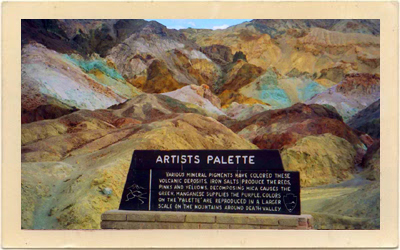 Location Site: Location Site:Artists Palette and Artists Drive, Death Valley, California (see Map) There are several scenes for Star Wars that were shot at this spectacular location in Death Valley. Among them are the following: 1) The camera pans down to show R2-D2 traveling through a narrow canyon in the desert, and 2) R2-D2 runs into trouble in the arroyo and eventually gets zapped and taken away. One scene that was filmed in Tunisia, showing the Jawas carrying R2-D2 towards the sandcrawler, had to be re-shot due to problems with the film. That re-shoot took place at this location, using children of the local Park Rangers as the Jawas. About Artists Palette: Artists Drive rises up to the top of an alluvial fan fed by a deep canyon cut into the Black Mountains. Artists Palette is on the face of the Black Mountains and is noted for having various colors of rock that have been stained myriad colors by the minerals within, creating a view that literally resembles an artist's palette. These colors are caused by the oxidation of different metals (red, pink and yellow is from iron salts; green is from decomposing tuff-derived mica; and manganese produces the purple). 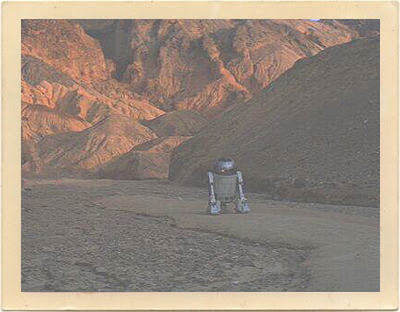 Called the “Artists Drive Formation,” the rock unit provides evidence for one of the Death Valley area’s most violently explosive volcanic periods. The Miocene-aged formation is made up of cemented gravel, playa deposits, and much volcanic debris, perhaps 5,000 feet thick. Chemical weathering and hydrothermal alteration are also responsible for the variety of colors displayed at Artists Palette and nearby exposures of the “Furnace Creek Formation.” Called the “Artists Drive Formation,” the rock unit provides evidence for one of the Death Valley area’s most violently explosive volcanic periods. The Miocene-aged formation is made up of cemented gravel, playa deposits, and much volcanic debris, perhaps 5,000 feet thick. Chemical weathering and hydrothermal alteration are also responsible for the variety of colors displayed at Artists Palette and nearby exposures of the “Furnace Creek Formation.”Right: The droid, R2-D2, moves through an isolated arroyo. This scene from the 1977 Sci-Fi classic, “Star Wars,” was shot in Death Valley, California, in an area called Artists Palette. Artists Drive loops for several miles through naturally colored hills at the base of the Black Mountains. It is a long, winding, one-way road, which is paved, leaving from Badwater Road, and returning a bit north of where it left. It climbs to a considerable height on the mountain side, dropping into gullies and wandering along narrow canyons. The colors, concocted in an ancient deposit of volcanic material, are truly remarkable. Once in a while a clump of desert holly, or a bit of grass can be seen. Near the middle of the loop, a short side road leads to the Artists Palette, the centerpiece of the amazingly colorful display. 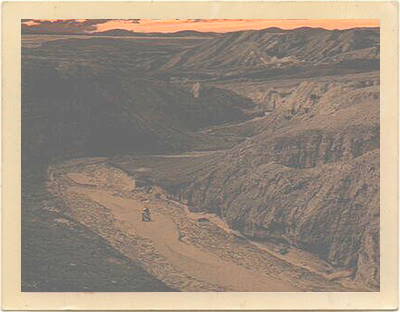 About Death Valley, California: About Death Valley, California:Death Valley, California (population 442, elevation 100 feet; 36° 14’ 48” N, 116° 49’ 01” W) is located near the border of California and Nevada, in the Great Basin, east of the Sierra Nevada mountains. Death Valley constitutes much of Death Valley National Park and is the principal feature of the Mojave and Colorado Deserts Biosphere Reserve. It is located mostly in Inyo County, California. It runs from north to south between the Amargosa Mountain Range on the east and the Panamint Mountain Range on the west; the Sylvania Mountains and the Owlshead Mountains form its northern and southern boundaries, respectively. It has an area of about 3,000 square miles. Right: R2-D2 makes his way through an isolated arroyo. This scene from the 1977 Sci-Fi classic, “Star Wars,” was shot in Death Valley, California, in an area called Artists Palette. Situated within the Mojave Desert, it features the lowest, driest, and hottest locations in North America. Badwater, a basin located in Death Valley, is the specific location of the lowest elevation in North America at 282 feet below sea level. This point is only 84.6 miles east-southeast of Mount Whitney, the highest point in the contiguous United States, with an elevation of 14,505 feet. And Death Valley holds the record for the highest reliably reported temperature in the Western hemisphere: 134°F at Furnace Creek on July 10, 1913. 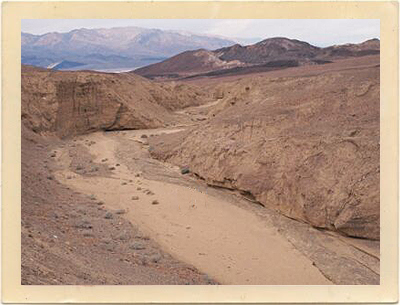 Death Valley also contains salt pans. According to current geological consensus, during the middle of the Pleistocene era, there was a succession of inland seas (collectively referred to as Lake Manly) located where Death Valley is today. As the area turned to desert, the water evaporated, leaving behind the abundance of evaporitic salts, such as common sodium salts and borax, which were subsequently exploited during the modern history of the region, which was primarily 1883 to 1907. Right: A photo was taken of the arroyo at Artists Palette in Death Valley, California, several decades after it was used as a location for George Lucas’ “Star Wars.” (See the photo above for the actual scene from the movie that was shot here.) The valley received its English name in 1849, during the California Gold Rush. It was called Death Valley by prospectors and others who sought to cross it on their way to the gold fields, although only one death in the area was recorded during the Rush. During the 1850s, gold and silver were extracted in the valley. In the 1880s, borax was discovered and extracted by mule-drawn wagons. Death Valley National Monument was proclaimed on February 11, 1933, by President Hoover, placing the area under federal protection. In 1994, the monument was redesignated as Death Valley National Park, as well as being substantially expanded to include Saline and Eureka Valleys. The valley itself is 130 miles long, between 6 and 13 miles wide, and is surrounded by steep mountain ranges. Its three million acres of wilderness and rich cultural history, make it a lifetime’s work to explore all that the valley has to offer. 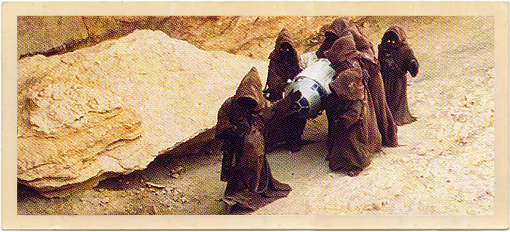 For travelers, the weather is too hot in summer for all but the hardiest of souls, with daytime highs over 100°F and surface temperatures approaching twice that. The best months to visit are December through February, when that days are mild. For travelers, the weather is too hot in summer for all but the hardiest of souls, with daytime highs over 100°F and surface temperatures approaching twice that. The best months to visit are December through February, when that days are mild.Right: The “Jawas” cart off R2-D2 after he breaks down. This scene was shot in an arroyo in Death Valley, California, in an area known as Artists Palette. Directions: From the East: • Take CA 190 west from Death Valley Junction, 20 miles into the park. • From US 95 in Nevada, take NV 374 west from Beatty, 19 miles into the Valley. From the West: • Going north on US 395, take CA 190 east from Olancha, through Panamint Springs and over Towne Pass. This road is steep and narrow along some sections and is slow going for vehicles pulling trailers. • Going south on US 395, take CA 136 east from Lone Pine to CA 190 east through Panamint Springs and proceed as above. From the North: • From US 95 in Nevada, take NV 267 west from Scotty’s Junction, 26 miles towards Scotty’s Castle. From Las Vegas: • Proceed north on US 95 to Lathrop Wells, then continue south on NV 373 for 23 miles to Death Valley Junction. Go west on CA 190 for 20 miles to the park entrance. Local Attraction: Furnace Creek Furnace Creek is a spring, oasis, and village that sits on top of a remarkably symmetrical alluvial fan. The main visitor center of Death Valley is located here, as well as the Furnace Creek Inn and resort complex. Controversy surrounds the use of Furnace Creek water to support the resort (complete with a swimming pool) and nearby facilities, including a golf course. The scarce springs and surrounding lush oases support thriving plant communities and attract a wide variety of animals. As the resort grew, the marshes and wetlands around it shrank. Lodging & Dining: Furnace Creek Ranch. Located in Furnace Creek, this establishment is a ranch style, family-oriented Inn with 224 rooms. Furnace Creek Resort offers four places to eat, including a casual cafe, an old-fashioned steak house, and the upscale restaurant at the Furnace Creek Inn. You’ll also find small restaurants and mini-marts at Panamint Springs and Stovepipe Wells. Below Right: The “Star Wars” production crew shooting scenes with the droids in Death Valley, California. 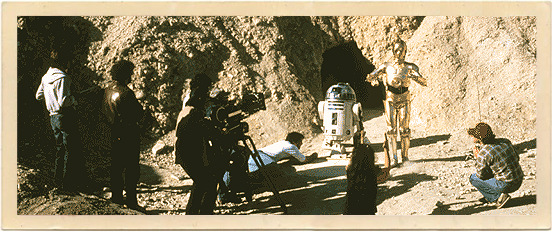 Awards: Awards:• Star Wars won Oscars in the following categories: Best Sound, Best Costume Design, Best Art Direction–Set Decoration, Best Effects–Visual Effects, and Best Film Editing. • Star Wars won the People’s Choice Award for Favorite Motion Picture. • Star Wars won the Los Angeles Film Critics Award for Best Picture. • Star Wars won the Evening Standard British Film Award for Best Film. • Star Wars won the Saturn Award from the Academy of Science Fiction, Fantasy & Horror Films for Best Science Fiction Film. • Star Wars won Saturn Awards from the Academy of Science Fiction, Fantasy & Horror Films in the following categories: Best Costumes, Best Make-up, Best Special Effects, and Outstanding Editing. • Star Wars was nominated for an Oscar for Best Picture. • Star Wars was nominated for a Golden Globe for Best Motion Picture, Drama. • John Williams won an Oscar for Best Original Score, Motion Picture. • John Williams won a Golden Globe for Best Music, Original Score. • John Williams won a Grammy Award for Best Album of Original Score written for a Motion Picture or Television Special. • John Williams won the Saturn Award from the Academy of Science Fiction, Fantasy & Horror Films for Best Music. • Alec Guinness won the Evening Standard British Film Award for Best Actor. • Alec Guinness won the Saturn Award from the Academy of Science Fiction, Fantasy & Horror Films for Best Supporting Actor. • Alec Guinness was nominated for an Oscar for Best Actor in a Supporting Role. • Alec Guinness was nominated for a Golden Globe for Best Motion Picture Actor in a Supporting Role. • George Lucas won the Saturn Award from the Academy of Science Fiction, Fantasy & Horror Films for Best Director. • George Lucas won the Saturn Award from the Academy of Science Fiction, Fantasy & Horror Films for Best Writing. • George Lucas was nominated for an Oscar for Best Director. • George Lucas was nominated for an Oscar for Best Writing, Screenplay Written Directly for the Screen. • George Lucas was nominated for a Golden Globe for Best Director, Motion Picture. • George Lucas was nominated for a Directors Guild of America Award for Outstanding Directorial Achievement in Motion Pictures. • Harrison Ford was nominated for the Saturn Award from the Academy of Science Fiction, Fantasy & Horror Films for Best Actor. • Mark Hamill was nominated for the Saturn Award from the Academy of Science Fiction, Fantasy & Horror Films for Best Actor. • Carrie Fisher was nominated for the Saturn Award from the Academy of Science Fiction, Fantasy & Horror Films for Best Actress. Star Wars won other awards, but there are too many more to list here. 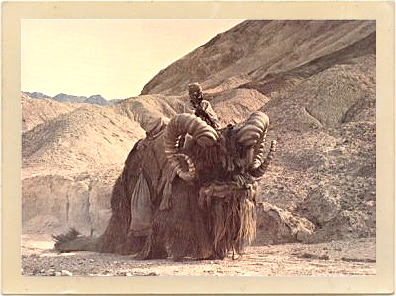 Movie Trivia: Movie Trivia:• When first released in 1977, this movie was simply titled Star Wars, as it was intended to be a stand-alone movie. Sequels were not considered until after it became wildly successful. The name of this movie was changed to “Star Wars: Episode IV–A New Hope” many years later, to fit in better with the names of the other films. • William Katt auditioned for the role of Luke Skywalker. • Alec Guinness always recalled the experience of making the movie as a bad one, and consistently claimed that it was his idea to have his character killed in the first film, so he “wouldn’t have to carry on saying these rubbish lines.” Contrary to this, George Lucas has said he made the decision to kill off Kenobi, that Guinness was “less than happy” his character was dying earlier than expected, and that Guinness appeared to enjoy his time on set. Right: A “bantha” creature is filmed in one of the remote areas of California’s Death Valley for George Lucas’ legendary movie “Star Wars.” • The first “bantha” to appear on-screen was in the original Star Wars. Computer-generated imagery was not used to create the creature. Rather, an elephant was dressed in a costume of fur and fake horns. This proved problematic for George Lucas during filming. The elephant was unaccustomed to heat, and during the filming of Tatooine scenes in Death Valley, California, its costume kept coming off. • The studio was unhappy with Star Wars as a title after negative market testing. A competition was held during shooting for cast and crew to come up with a better one. • When 20th Century Fox attempted to distribute Star Wars in America, fewer than 40 theaters agreed to show it. • Prior to the release of Star Wars, the greatest profit 20th Century Fox had ever made in one year was $37,000,000. In 1977, because of this film, their year-end profit was $79,000,000. • Following principal photography, new scenes had to be filmed for the “Cantina” scene, to give it more diversity and add more aliens. However, the reshoot set was very small. If you look at the close-up scenes of most of the aliens, when Luke and company enter, you can see the same window in the background. 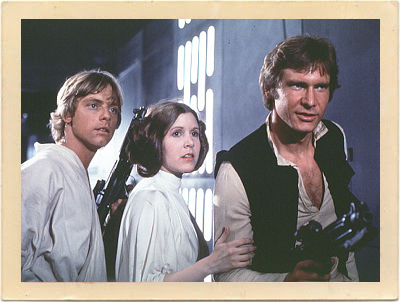 • George Lucas planned to score the film with existing classical music like Stanley Kubrick had done on 2001: A Space Odyssey (1968), before Steven Spielberg introduced him to composer John Williams. Lucas and Williams agreed on a classical 19th-century Romantic music style with liberal use of leitmotif for the score. • George Lucas planned to score the film with existing classical music like Stanley Kubrick had done on 2001: A Space Odyssey (1968), before Steven Spielberg introduced him to composer John Williams. Lucas and Williams agreed on a classical 19th-century Romantic music style with liberal use of leitmotif for the score.Right: The three young breakout stars of the 1977 Sci-Fi classic, “Star Wars”: Mark Hamill (as Luke Skywalker), Carrie Fisher (as Princess Leia), and Harrison Ford (as Han Solo). • Kurt Russell, Nick Nolte, Christopher Walken, Jack Nicholson, Al Pacino, Chevy Chase, Steve Martin, Bill Murray, and Perry King were all candidates for the role of Han Solo, as George Lucas wanted to stay away from any actors he had previously used in his films. Harrison Ford (who had played Bob Falfa in Lucas’ American Graffiti) read the part of Han Solo for screen tests of other characters, but wasn’t originally considered for the part. • Carrie Fisher found the dialogue to be very difficult, later saying, “You can type this stuff, but you can’t say it.” Harrison Ford had similar trouble, and persuaded George Lucas to let him change several lines. • At one point, George Lucas had planned for the character of Han Solo to be a huge green-skinned monster with gills. Then, Lucas decided that Han Solo would be a black human. He auditioned several black actors and even musicians (including Billy Dee Williams), until finally settling on Glynn Turman. But, eventually, Lucas decided to make Han Solo white, and went with Harrison Ford. • Peter Mayhew, who played Chewbacca, worked as an orderly in a Yorkshire hospital prior to being cast in the movie. He won his role ten seconds after meeting George Lucas for the first time; all the 7’2” Mayhew had to do was stand up. • Stunt doubles were not used for the scene in which Luke and Leia swing to safety. Carrie Fisher and Mark Hamill performed that stunt themselves, shooting it in just one take. • Interested in creating a modest line of colorful space toys, Kenner Toys signed on for the merchandising shortly before Star Wars opened, although they did not believe the movie would be a hit. When Star Wars became a hit, they were unprepared to handle the demand and could not produce enough Star Wars toys to handle the demand for Christmas. Instead, they sold boxed vouchers for various toys. The toys sold in the “Empty Box” campaign during December were not delivered until the following March. Character Quote: “Help me, Obi-Wan Kenobi. You’re my only hope.” ~Princess Leia (Carrie Fisher) |
|